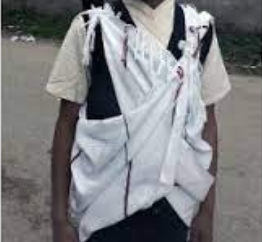These boots are made by the artisans of the Bhutia community in Kalimpong, Darjeeling. These were traditionally made for the male Tibetans living in the mountainous region who used to walk long distances with their yaks and thus needed warmth and protection from the climate and the rough terrain, respectively. Earlier the Tibetans used to tie a leather bag around their feet to keep them warm.
The boots have a thick leather sole to help walk in the mountains. They have high layered sides made of either leather or thick cloth. The rear upper end of the boots is left open to be tied by a hand-braided belt after being worn.
Konglan boots are usually worn by the wealthy Tibetans and Bhutanese as a part of their formal attire. These are made of leather, a heavy woollen cloth and khochen (a silk-like material). These boots are heavily brocaded on the upper part. The brocade fabric is traditionally from China. The soles are made of yak or sheep leather. The inner lining is sometimes made of fur and no socks are worn. A thick felted cloth is used for the part covering the feet.
The tools used in the making of the boots include needles, a pair of scissors, knives, white cotton thread, jute, felt, rubber sole, fine embroidery threads, glue made out of dough, squeezy (to apply the glue) and a wooden block and plank for beating and pressing.
The unique characteristic of the Konglan knee boots is that a boot of a pair can be worn on either foot. These are of better quality than any other boots of the region, and also have elaborate brocade work on them. Other boots made by the craftsmen are Sombas or Do-cha /ladies boots, Lhamor Pumalam /Tibetan dance boots, Reysun /boots worn by monks, Ghalo (boots worn by regular people), Shuozo (worn by kings and authorities), Jhelum (worn by kings) and Teylam (worn by warriors).
Gallery
YOUR VIEWS
PRACTITIONERS: INDIA
Access 70,000+ practitioners in 2500+ crafts across India.
BIBLIOGRAPHY
10,000+ listings on arts, crafts, design, heritage, culture etc.
GLOSSARY
Rich and often unfamiliar vocabulary of crafts and textiles.
SHOP at India InCH
Needs to be written.






